There is a word that just about everyone who has seen Moira Finucane perform uses in connection with her art. It’s the word my editor used when I suggested this interview. And the word The Age picture editor used when I booked a photographer.
It’s also the word fans the world over have used in relation to the cabaret queen.
“Legend.”
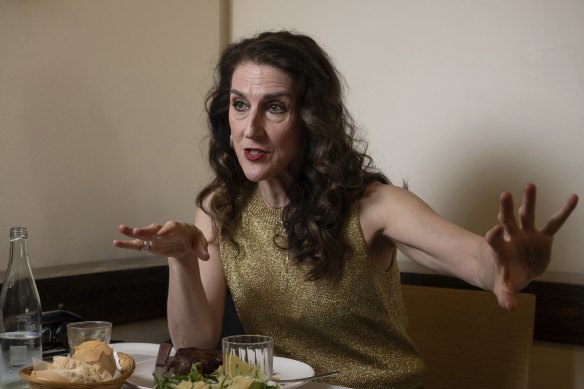
Moira Finucane at Marios in FitzroyCredit: Penny Stephens
While in general it’s probably an overused word for people who have been great at what they do for a long time, there are few others as perfect for Finucane.
For one thing, the word legend is an official designation as she was named the Fringe Living Legend last year for her longstanding commitment to Melbourne’s festival of the provocative, wild and weird. And for another, she invented this form of boundary-pushing cabaret 20 years ago with her racy, genre-defying, unconstrained work The Burlesque Hour, which was only sort of burlesque, definitely more than an hour and a huge, untested risk.
“When we made The Burlesque Hour, there was no burlesque movement,” Finucane says. “I started using the word burlesque for my club work, and I think I called them burlesque bizarre. A burlesque means a mockery, a grotesquery, an exaggeration.
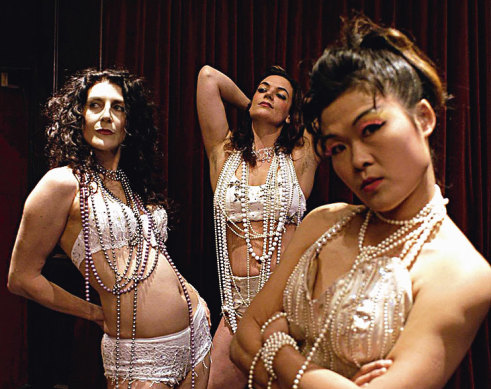
Moira Finucane, Azaria Universe and Yumi Umiumare in 2004’s The Burlesque Hour.
“So in the olden days, there used to be burlesque books, which poked fun at societal mores and burletta operas. It was a form that took what’s happening in society today and blew it out of proportion, and so that’s why I started calling my work burlesque because it was wild and it was a mockery, a grotesquery, an exaggeration.”
Despite her confirmed, official legend designation, Finucane is delighted when I tell her it’s the word that keeps cropping up. “Am I really a legend?” she asks, laughing. “I don’t feel like a legend. Do I seem like a legend?”
Yes, I tell her. Absolutely. And there is another word audiences bestowed upon her for the first time when she was performing in Buenos Aires. She had worked with a Spanish coach to translate her monologue into Spanish, and she delivered it in a mixture of languages, over the coach’s admonition that doing so would look amateurish.
“There we were in Buenos Aires, and on opening night, I didn’t know what was going to happen, but it worked,” Finucane says. “And as I walked out of the theatre on opening night, everybody started saying, la diosa! I didn’t even know what that means, as of course, I didn’t speak Spanish.”
I confess to her that I, too, do not know what it means.
You can take it as read that the look she gave me was intense because, it seems, everything Moira Finucane does is intense.
“It means the goddess.”
We have met, la diosa and I, at Fitzroy Italian café Marios, which has been such a fixture in Melbourne’s dining scene for almost 40 years that it, too, deserves the L-word.
It also happens to be Finucane’s local and has been a staunch supporter of her work since the beginning. Post-show drinks, important lunch meetings and creative confabs have all taken place at Marios, plus plenty more besides.
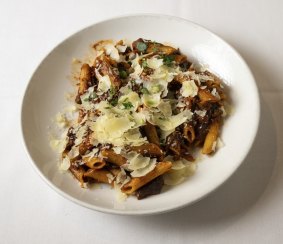
Penne with beef ragu and shaved parmesan at Marios Cafe in Fitzroy.Credit: Penny Stephens
When Finucane enters, a whirlwind of dark curls and gold, she gives the waiters and barista hugs and asks them if they are coming to her show – she has arranged comp tickets for the entire staff for opening night.
Within a few minutes of meeting me, she has offered tickets to me also, and to Age photographer Penny Stephens.
Finucane sticks with her usual order, the porterhouse steak, medium-rare, with a side salad of rocket and parmesan. I choose the lunchtime pasta special, slow-cooked beef ragu over penne. Everything is delicious, hearty and home style.
We will both end up taking doggy bags home as our three-hour conversation is so animated it gets in the way of chewing. We stick with mineral water, though we feel the pull of sparkling wine.

Porterhouse steak with crispy potatoes at Marios in Fitzroy.Credit: Penny Stephens
But back to la diosa. With her Irish heritage and spiritual upbringing, Finucane loves to visit churches wherever she travels, and she did so in Argentina.
“I saw one of their la diosas, and she was really severe looking,” Finucane says. “Their saints were very tall and thin, but one Virgin Mary I saw had black eyes and lightning bolts coming out of her hands. It was as if some of the worlds of my imagination were there in real life.”
Like la madonna, there’s a dichotomy to Finucane: the passionate intensity, coupled with a warmth and generosity of spirit. A goddess she might be, but not a vengeful one. She might be venerated (“Do you want to contribute a quotable quote about how fantastic I am?” she asks the eponymous Mario, playfully, as he stops by to say hello), but she worships her audience just as much as they worship her.
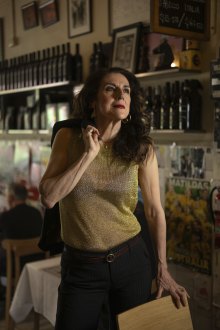
Moira Finucane at her local, Marios café in Fitzroy.Credit: Penny Stephens
“When you come to our shows, you are treated beautifully,” she says. “You’re shown to your seat, everyone is treasured.”
She calls this form of worship radical hospitality, and it was shaped by two formative events. Finucane trained as an environmental scientist, with a concentration in environmental law, spending the first half of her career as a lobbyist at The Wilderness Society.
She recalls a flight home from an intense week in Canberra, bone tired, and telling a friend of her exhaustion and disillusionment. “She said, ‘what are you going to do about that?’” Finucane recalls. “And I said, ‘I think I’m going to quit’… I was so tired I didn’t even think about what was coming out of my mouth. She said, ‘oh, what are you going to do then?’ And I said ‘oh, I might try acting’.”
It was a circuitous route from that plane conversation to selling out genre-defying shows, but an early success brought her and her creative and life partner, Jackie Smith, to London for a run of shows.
While there they scraped together their money to see a show at the Fortune theatre. “When I came in, they said, ‘Oh, why don’t you order a drink at the bar so you can get something at interval?’ And I thought, ‘Oh, how lovely’. And then I sat down in this beautiful velvet seat, and I felt really special.
“And then you could put 10p in and get some binoculars. Above me there was this huge chandelier, and all of the places that I’d been performing at were contemporary theatres where all of the glamour was on stage and there was no glamour in the audience. And I thought to myself, ‘I want my audience to feel immersed, embraced, beloved, and to go on that journey with me’. And that was the moment that changed my life.”

Moira Finucane in The Rapture.Credit: Jodie Hutchinson, Vanessa Fernandez
The second moment also happened in those early days of artistic and financial struggle. Trailblazing vaudeville and cabaret star Toni Lamond, who is now in her 90s, was in town, and Finucane and Smith were desperate to see her. The problem: Lamond was doing a dinner show, and Finucane and Smith couldn’t afford tickets.
Finucane decided to try her luck anyway. “I wrote to her: ‘Dear, Ms Lamond, we’re theatre artists. We’re very poor, but we love you dearly. Could we please come and stand at the back?’ And she rang me. I still have the answering machine tape. She rang me and said, ‘It’s Toni Lamond here. I’ll organise tickets for you’.”
The young artists brought Lamond a bunch of flowers and went to the venue, telling the front of house that Lamond had said they could sit at the back. The staff said, “oh, you’re those girls”, and ushered them to the front row of the dress circle, asking what they’d like to drink. Finucane and Smith demurred, citing their empty wallets, and the staff member said, “Ms Lamond is taking care of you tonight”.
They each had a chardonnay and watched their idol, enthralled. “She sang a song about the hungry years, about when you dream, you reach for the stars, the days of long ago and how you miss them when they’re gone,” Finucane remembers. Lamond found the pair after the show and gave them words of encouragement for their own careers, words that have resonated through the years.
“In every single season, we do a Toni Lamond, someone who writes to us or someone who might have bought – we always have cheap tickets. We always have artist tickets, and we always have share-the-joy tickets, which means, if you need joy but you can’t afford them, we’ll shout you. And then we pick one of those share-the-joy people, and we upgrade them to the front row. We buy them drinks. We Toni Lamond them.”
And Lamond? The very last season she performed before retiring was one of the many iterations of Finucane and Smith’s The Burlesque Hour.
Finucane, now 60, says she herself is at least three decades from retirement, perhaps more. Her upcoming Fringe show is a celebration of 20 years since the premiere of The Burlesque Hour, but she’s calling it a ‘future-spective’, no rosy-tinted nostalgia here. She’ll be performing alongside long-time collaborators like jazz and cabaret singer Mama Alto, butoh dancer Yumi Umiumare and fellow Fringe Living Legend Maude Davey.
What goes through Finucane’s mind when creating a new, boundary-pushing show?
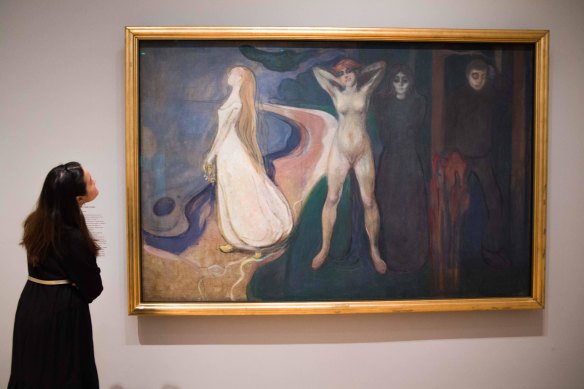
A woman looks at Woman in Three Stages, by Edvard Munch.Credit: Alamy Stock Photo
One of Finucane’s favourite visual artists is Edvard Munch, and she found herself transfixed by his Woman in Three Stages while at a museum in Bergen, Norway. And when la diosa is captivated, she turns the full force of her intensity on her subject. She stared at it for a full two days.
“In the middle of that painting is a big red, sort of human-sized blob,” Finucane says. “And there’s the three stages of women. There’s a virgin looking out to the ocean. She’s sort of sketchily painted in. There’s a woman in her incredible power, the height of her wild, sexual power, she’s incredibly detailed, just looking full of life and passion. And then there’s a woman who’s grieving and mourning, dressed in black, and they’re all very beautiful.
“And then there’s this giant red blob that’s as big as they are. And then there’s a man … The red blob was very controversial at the time. What is this red blob? The red blob spoils the painting. And over time, the red blob has become uglier. It’s become cramped ... And I sat there for two days thinking about that little blob ... And I thought, you know, all work should have a red blob in it. Something that is so visceral, something that is inexplicable, something that is an opportunity for other things to happen.”
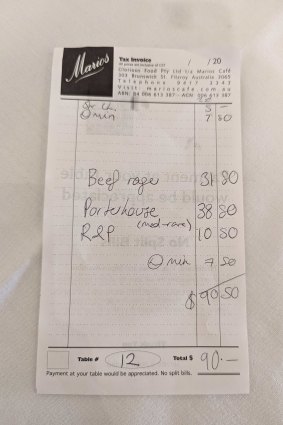
The bill: beef ragu pasta, steak and a salad.Credit: Cassidy Knowlton
La diosa is a goddess of love, making sure her audience is treasured, supporting her beloved local pasta institution instead of a buzzy fine diner for our interview, sending out 800 jars of homemade grapefruit marmalade for free to strangers around the world just to brighten people’s days during the pandemic, showering young artists with gifts (and me – she presents me with memorabilia from her previous shows, as well as a beautiful painted porcelain heart by artist Catherine Lane, one of many she gave to visitors of the National Gallery of Victoria while she was its inaugural Creative Fellow in 2016).
But she is also a goddess crackling with the wild energy of an incongruous red blob, firing as lightning from her hands.
Finucane and Smith’s Global Smash Club is on at the ETU Ballroom at Trades Hall from October 16-19.